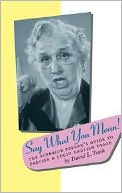Say What You Mean!: A Troubleshooter's Guide to English Style & Usage
Search in google:
Long before Lynne Truss took up her sharp blue pencil on behalf of proper punctuation, the Anglo-American linguist R. L. Trask was fighting his own delightfully opinionated fight for standard written English. Say What You Mean! lays down the laws for writing simple, effective, and unambiguous sentences, the kind that deliver the facts, influence opinion, and make things work throughout the English-speaking world—and that every English-speaking grown-up must know how to write if he wants to be understood by others."If your readers cannot realize at once exactly what you mean, then you have failed as a writer," says Trask. This is refreshingly blunt. So are these imperatives: "Use plain words. Avoid jargon. Read what you've written. Edit it and polish it. Work hard to be sure that your meaning is clear."Since it was published in England in 2001, Say What You Mean! has become a must-read among writers, educators, and language-mavens—everyone who needs to know the difference between lesser and fewer, disinterested and uninterested, and hire, rent, and charter. It has also become legendary for its "cheek," evident in such entries as the following:- artiste: This pretentious word . . . commonly means "fraud pretending to be an artist." Don't use it unless you mean to be insulting.- exciting: In an advertisement, an exciting book means nothing more than "a book that we are selling." Unless you are obliged to write such dross for a living, you are advised to confine this word to its literal sense of "thrilling."- viz.: This Latin abbreviation means "namely," and it should not be used. Write namely instead.Practical, bracing, and wonderfully readable, here is a newclassic—a style guide that belongs on the shelf next to Fowler, Gowers, and Strunk & White.








